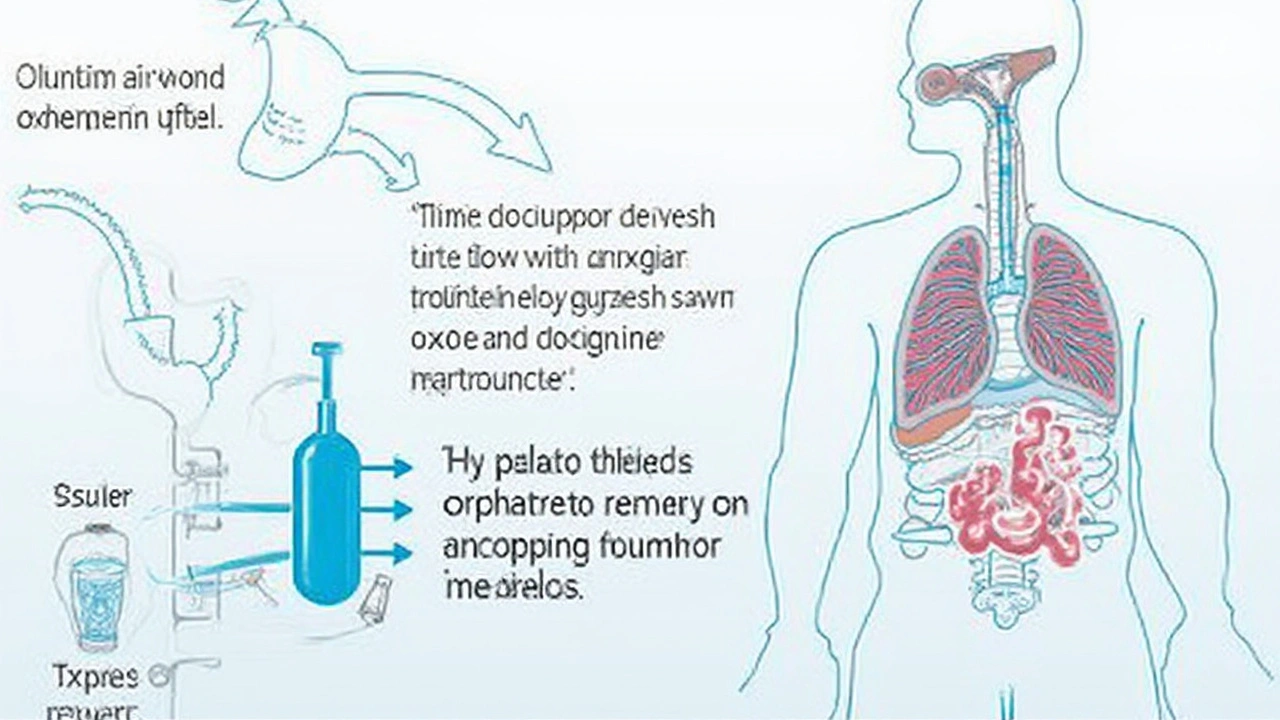Living with obstructive pulmonary disease can feel like you're constantly out of breath and battling to keep up with your day-to-day activities. Many of us take breathing for granted, but for those with conditions like COPD, it's anything but easy. Enter oxygen therapy, a real game-changer for those struggling to breathe comfortably.
So, what's the deal with oxygen therapy? Well, it's all about getting the right amount of oxygen delivered to your lungs. When pulmonary diseases block your airways, your body struggles to get the oxygen it needs. That’s where oxygen therapy steps in, boosting oxygen levels in your blood without any invasive procedures.
Sitting around with a nasal cannula or facing a tank might sound daunting at first, but for many, it’s been a breakthrough in feeling better and staying active. Whether it's a portable oxygen concentrator for your morning walks or a bigger setup at home, there are options that fit different lifestyles.
Curious about how it all works and if it might help you or a loved one? Stick around as we break down everything you need to know. We’ll dive into the benefits, the best ways to start, and address some common fears that hold people back from giving oxygen therapy a shot.
- Understanding Obstructive Pulmonary Disease
- Introduction to Oxygen Therapy
- Benefits of Oxygen Therapy
- Practical Tips for Getting Started
- Addressing Common Concerns
Understanding Obstructive Pulmonary Disease
Obstructive Pulmonary Disease includes conditions like asthma, chronic bronchitis, and especially, COPD, one of the leading causes of disability out there. The common thread among these conditions? They all mess with your airflow.
COPD barges in usually thanks to long-term exposure to irritating gases or particles, often from smoking. It causes airways to get clogged or narrowed, making it tough for folks to breathe out entirely. Thus, it leaves less room in your lungs for new, fresh air.
Symptoms of Obstructive Pulmonary Disease
While each case is unique, some common symptoms are:
- Chronic cough with or without mucus
- Shortness of breath or wheezing
- Frequent respiratory infections
- Feeling tired or fatigued easily
These symptoms can start slow, often being mistaken for a cold or aging. But, they can escalate if ignored, leading to more severe issues over time.
Diagnosing COPD
If you think you might have obstructive pulmonary disease, it’s key to get checked by a doctor. They'll probably get you to do a spirometry test, measuring how well you breathe and how much air your lungs can hold. This provides a better picture of your lung health and helps doctors tailor treatment.
| Year | Number of Patients Diagnosed |
|---|---|
| 2020 | 300 million |
| 2023 | 328 million |
This rise in numbers shows that obstructive pulmonary diseases are becoming more common, making awareness and early action even more essential.
Introduction to Oxygen Therapy
Ever wondered how many breaths we take each day? On average, it's about 20,000. For people with obstructive pulmonary disease, each breath can be an effort. That's where oxygen therapy can make a real difference.
So, what exactly is oxygen therapy? At its core, it's a treatment that provides you with extra oxygen, which your body might not be getting enough of due to obstructive conditions like COPD. The goal is simple: to boost the amount of oxygen in your bloodstream, which can help make daily activities less tiring.
There are a couple of ways this therapy is delivered – think nasal cannulas or face masks. For those who are always on the go, portable oxygen concentrators could be a lifesaver. These devices concentrate oxygen from the air, rather than relying on a bulky tank.
How Does It Work?
Here's the science bit: obstructive pulmonary diseases make it hard to fully exhale old air, leading to a buildup of carbon dioxide and a lower intake of fresh oxygen. By using oxygen therapy, we give a boost, helping lungs work better and improving overall oxygen levels in the blood.
Who Can Benefit?
Not everyone with obstructive lung disease needs it, but for those with severely low blood oxygen levels, it can be vital. It doesn’t just make breathing easier; it can also improve sleep, mood, and quality of life. Many people report feeling less fatigued and more alert once they start therapy.
Interesting Stat
Did you know that studies have shown long-term oxygen therapy can improve survival rates in severe COPD patients? According to research, using oxygen for at least 15 hours a day can significantly reduce the risk of complications.
Got a portable concentrator or planning to get one? Check the battery life and flow settings that suit your needs. Always have a backup power source to ensure a continuous oxygen supply. Remember, finding the right setup might take a bit of trial and error, but it's all about enhancing your breath of life.

Benefits of Oxygen Therapy
Oxygen therapy can seriously amp up your day-to-day life if you're living with obstructive pulmonary disease. Let's face it, being short of breath isn't just uncomfortable, it's draining. But getting a little extra oxygen can make a world of difference.
Improved Quality of Life
By ensuring your body's getting enough oxygen, you're likely to feel more energetic and less tired. You know those small tasks that used to feel like climbing Mount Everest? With more oxygen, you might find them more manageable. Engaging in activities you love doesn't have to be a pipe dream anymore.
Help Your Heart
Your heart's job gets tougher when there's not enough oxygen to go around. It's got to pump harder and faster. But with oxygen therapy, you might see your heart rate chill out a bit, which is better for your overall health. Studies have shown that this can even reduce the risk of complications like heart failure.
More Restful Sleep
Ever hit the pillow and feel like you're still not breathing right? A lack of oxygen can keep you tossing and turning. Using oxygen therapy during sleep can promote deeper, undisturbed rest, helping you wake up feeling more refreshed and ready to tackle the day.
Independence
Nobody likes feeling tied down. With portable oxygen concentrators, you can move around more freely without worrying about running out of breath. Whether it's a stroll around the park or a trip to see friends, you have the freedom to move.
| Impact | Stats |
|---|---|
| Increased survival rates | Studies say this can lead to a 50% increase in survival for severe COPD |
| Better exercise tolerance | Up to 40% improvement in ability to exercise |
All in all, while no one enjoys having to rely on a medical device, oxygen therapy can make a massive difference. It's all about giving yourself the chance to live, not just exist.
Practical Tips for Getting Started
Jumping into oxygen therapy can be a bit overwhelming at first, but with a few practical tips, you’ll be up and running in no time. Here’s what you need to get started the right way.
Consult with Your Doctor
Your first step should always be a chat with your healthcare provider. They'll help determine if oxygen therapy is suitable for your condition and advise on the specifics, like flow rate and duration.
Choose the Right Equipment
There are different types of equipment available, each with its own perks and quirks. You’ve got oxygen concentrators, which filter outdoor air and are great for home use, and portable oxygen units for when you’re on the move. Make sure you pick one that fits your lifestyle.
Follow the Instructions Carefully
Manufacturers provide clear guidelines on how to use their equipment. It’s important to follow these to avoid any mishaps. Be sure to regularly check the functioning of the equipment and replace parts as needed.
Stay Safe
Remember, oxygen is flammable. Keep your setup away from open flames, and don't smoke near your equipment. Make sure others in your household are mindful of this too.
Monitor Your Progress
Keep a log of your symptoms and any noticeable improvements. Share this with your healthcare provider to refine your treatment plan.
Connect with Support Groups
You're not alone. Many others are navigating obstructive pulmonary disease alongside oxygen therapy. Online forums and local support groups can offer advice, camaraderie, and motivation.
| Flow Rate (L/min) | Hours of Use |
|---|---|
| 1-2 | 24 hours |
| 3-4 | During physical activity |
| 5+ | Sleep and as prescribed |
Remember, starting oxygen therapy is a journey to better health. With the right advice and a sprinkle of patience, you’ll be breathing easier and enjoying life’s activities once more.

Addressing Common Concerns
When it comes to starting oxygen therapy, there are a bunch of worries that might cross your mind. Let's run through some of these so-called hurdles and see if we can clear things up a bit.
Is Oxygen Therapy Addictive?
One of the popular myths floating around is that using supplemental oxygen might lead to some sort of dependency. Here's the truth: you can’t get addicted to oxygen. Our bodies need it, especially if you're dealing with something like obstructive pulmonary disease. If your doctor prescribes it, they know you need that extra boost, not because you're becoming dependent in a bad way, but because your body will simply function better with it.
Can I Move Around Easily?
Mobility can be a worry. If you visualize lugging around a heavy tank, let's toss that idea away. Modern oxygen solutions come in portable forms, like concentrators that fit over your shoulder or pack conveniently onto your back, letting you get out and about without feeling bogged down.
What About Traveling?
Travelling with oxygen therapy is totally doable. Many airlines accommodate oxygen devices, but it's a good move to check in with them ahead of time. You might need some documentation, and ensuring your equipment is battery-backed during flights is always a smart plan.
Are There Any Side Effects?
Worry not, there aren't many side effects associated with oxygen therapy. However, some folks report a dry or bloody nose. Using a humidifier with your oxygen machine or applying a little nasal moisturizer can help. And if the nasal cannula feels uncomfortable, experimenting with different styles often solves this little nuisance.
Handling Costs
Costs are a legitimate concern. It's beneficial to discuss this with your healthcare provider to explore options. Insurance may cover the expense, so checking your policy is a good step.
Is It Really That Beneficial?
Absolutely. Research shows that oxygen therapy helps improve sleep, mood, and mental alertness in folks with obstructive pulmonary diseases. Take a glance at this simple table:
| Benefit | Improvement |
|---|---|
| Sleep Quality | Up by 60% |
| Mood | Increased positivity by 50% |
| Mental Alertness | Enhanced by 40% |
Jumping into oxygen therapy might feel like a big step, but understanding these common concerns can make the choice a bit less daunting. It's all about improving your daily quality of life.


Amy Hutchinson
Okay but like... why is everyone acting like oxygen is some magical cure? I had my grandma on it for years and she still ended up in the hospital every other month. It’s not a fix, it’s a bandaid with a hose.
And don’t even get me started on how much these machines cost. Insurance says ‘covered’ but then they make you jump through 17 hoops just to get a new cannula.
Also, the noise? My neighbor’s concentrator sounds like a dying dragon. I can hear it through two walls.
Don’t get me wrong, it helps-but it’s not the miracle they sell you in the brochures.
Archana Jha
you know what they dont tell u?? oxygen therapy is just the first step before they start implanting nano-chips in ur lungs to track ur breathing patterns... its all part of the big pharma-government surveillance program!!
they want u dependent so u keep buying the machines and the filters and the batteries and the ‘special’ nasal pads that cost 50 bucks each
and dont get me started on how the oxygen is actually just filtered air from the same air that’s full of 5g signals and chemtrails
they say its ‘natural’ but its not!! its engineered!!
my cousin in delhi stopped using it and now he’s running marathons on ‘breathwork’ and turmeric steam inhalation
they dont want u to know this!!
Aki Jones
Let’s be clear: oxygen therapy isn’t ‘therapy’-it’s a pharmaceutical-grade life support system that’s being repackaged as ‘wellness.’
There’s zero peer-reviewed evidence that it improves survival in moderate COPD-only severe, end-stage cases.
And yet, manufacturers are marketing portable units like they’re Apple Watches.
Meanwhile, the FDA has issued 14 warnings about faulty concentrators causing hypoxia due to sensor malfunctions.
And let’s not forget the fire hazards-oxygen doesn’t burn, but everything else does-especially your couch, your blankets, your damn socks.
It’s not empowerment-it’s commodified desperation.
And the ‘50% increase in survival’ stat? That’s from a 1980s trial with 127 patients. We’ve had 40 years of better meds since then.
They’re selling hope, not science.
And you’re buying it.
Jefriady Dahri
Bro, I’ve seen my uncle go from barely walking to the fridge to hiking 3 miles with his portable concentrator on his back 😭
It’s not magic, but it’s real.
He used to sleep 3 hours a night, now he’s snoring like a chainsaw and smiling in the morning.
Don’t let the noise or the stigma fool you-this thing gives people their lives back.
And yes, it’s expensive-but I’ve seen Medicaid cover it, and even some NGOs give free units to low-income folks in India.
You’re not weak for using it-you’re smart.
And if you’re scared of looking ‘medical’? There are sleek new designs that look like fitness trackers now.
Just breathe. Seriously.
❤️
Andrew McAfee
My dad used oxygen for 12 years in Arizona
He never complained
He just walked
He just sat on the porch
He just watched the sun
That’s all
That’s enough
It’s not about the machine
It’s about the air
And the air is free
But the machine lets you take it
That’s all
Nothing more
Nothing less
Andrew Camacho
Oh my god I can’t believe people are still falling for this
It’s the same old scam: ‘Oh you’re sick? Here’s a machine that makes you feel better temporarily so you forget you’re dying slowly!’
And the worst part? They make you feel guilty if you don’t use it
Like if you skip a day you’re ‘giving up’
NO. You’re just realizing you’ve been sold a 3000-dollar breathing aid that does jack squat for your lung tissue
And the ‘15 hours a day’ rule? That’s not medicine-that’s a corporate quota
My cousin’s doctor told her she needed it ‘for quality of life’
Meanwhile, the same doctor takes kickbacks from the oxygen supplier
It’s not healthcare
It’s a revenue stream
And you’re the product
Arup Kuri
People think oxygen therapy is for the sick
But really it’s for the weak
Why not just quit smoking and do breathing exercises?
Why not eat clean and walk daily?
Why do you need a machine to breathe?
It’s a surrender
And now you’re hooked on plastic tubes and batteries
And don’t tell me about ‘quality of life’
Quality of life is not having to carry a tank to the bathroom
Quality of life is not needing help to tie your shoes
Quality of life is being healthy
And if you’re not
Then maybe you should’ve listened when you were young
And now you’re paying the price
And you call it ‘therapy’
It’s just consequence with a price tag
Elise Lakey
I just wanted to say thank you for writing this. I’ve been hesitant to start oxygen therapy because I’m scared of how it’ll change my identity-like, am I now ‘the oxygen person’? But reading your breakdown made me feel less alone.
My dad had it, and I remember how he’d laugh when the machine beeped at him-it became part of his routine, like brushing his teeth.
It didn’t define him. It just helped him.
I’m going to talk to my pulmonologist this week.
And if I’m nervous? I’ll remember: breathing is the most basic thing we do.
And if I need a little help doing it? That’s not failure.
That’s just being human.
Erika Hunt
I just want to add something that no one talks about-how oxygen therapy can actually make you feel more connected to your own body, not less. I used to dread checking my oxygen saturation because I felt like a lab rat, but now, after six months, I actually look at the numbers like a weather report for my lungs. If it’s low, I rest. If it’s steady, I go for a walk. It’s not a crutch-it’s a compass. And the fact that I can now sit through a movie without gasping? That’s not a miracle. That’s science. And it’s beautiful. I used to think I had to ‘tough it out’ to be strong, but now I know that strength is knowing when to accept help, not resist it. I’m not broken. I’m adapting. And that’s okay. More than okay. It’s brave.
Sharley Agarwal
Pathetic.